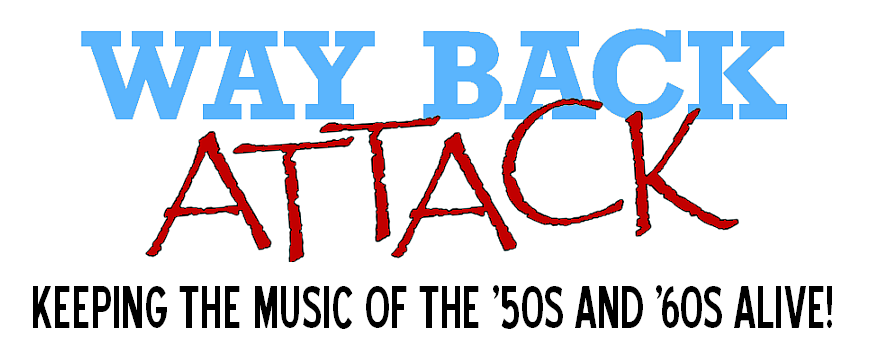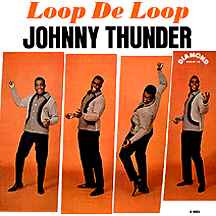JOHNNY THUNDER
Loop De Loop
Gil Hamilton grew up in Leesburg, Florida and studied agriculture at Florida A&M. After that he spent several years working as a driver for a local taxi service, though his main goal was to make it as a singer. His friend Lacey Hollingsworth left Leesburg and lucked into a job as a valet and road manager for The Drifters. When an opening for a singer came up during the group's late 1950s overhaul, Hollingsworth called Gil, who headed to New York for his big break. Big it wasn't; he was in and out of the lineup pretty quickly (a pattern not uncommon considering there were 50-odd Drifters singers over the years), but it was a good stepping stone, leading to opportunities for him to make records as a solo act. I've heard Gil Hamilton's name thrown around for a long time, but for many years was unfamiliar with his work or the fact that he and Johnny Thunder are one and the same.
Under his birth name, Gil's first single, "Much Obliged," appeared on the Fury label in 1960. For a couple of years he did session work as a backing singer, crossing paths with Dionne Warwick before either of them had a hit single. In the summer of 1962, he popped up on Capitol with the Bert Berns song "Tell Her." Several months later, Jerry Leiber and Mike Stoller produced the classic version by The Exciters as "Tell Him" (followed soon after by Billie Davis's hit U.K. version). Gil's was the original, but it had fallen off the radar. He had a hit somewhere inside him, but it just hadn't come out yet. Another 1962 release, "Move and Groove" on Vee-Jay, showed some promise but also didn't click. It appears the secret of success was for Gil to change his name, but it was up to someone else to make that suggestion.
Teddy Vann was a singer-songwriter looking for a hit of his own at the start of the '60s. There were a few brushes with success: "Teenage Hayride," an instrumental reimagining of "Three Blind Mice" (with a brief vocal before a weird, abrupt two-word ending: 'Why not?'), was written, produced and arranged by Vann and billed as Tender Slim. It showed up near the bottom of the national charts in January 1960, while The Wheels, with Teddy as lead singer, received airplay in some markets with "Clap Your Hands" (a different song than the hit by The Beau-Marks a few months later). Within weeks, "Cindy" had a nice run under Vann's name, then in June '61 he appeared again on the charts with a ballad he'd composed, "The Lonely Crowd," on Columbia. He liked Hamilton when the two met around the fall of 1962. Each had put out several records and had a little big label experience but no major success. Teddy had discovered when trying to promote himself as a singer that he was uncomfortable in front of the camera, so he embraced the writer-producer role.

As the story goes, "Loop De Loop," based on a dance (or you could say a game) for children, was fashioned into a complete song in about 30 minutes by Vann and his brother-in-law Joe Dong (who was later married to Estelle Bennett of The Ronettes). At a Bell Sound Studios session, Gil (and uncredited backing singers The Bobbettes) did the tune in one take, after which Teddy took the master straight over to Diamond Records, just blocks away, and made a deal to have it released under the name Johnny Thunder. The record was a top ten smash in early 1963, at the same time the Exciters were there with their rendition of his ill-fated Capitol single. "Loop De Loop" was perhaps the most juvenile of all the dance records to come in the wake of the world-altering "Twist," yet Johnny's exuberant vocal, a constant and distant-sounding organ, and a strange male chorus toward the end with a Munchkin-like "Lollipop Guild" vibe makes for an undeniably enjoyable two minutes and 12 seconds. If your tendency is to write off the song as something less than soulful, one listen to Frankie Vaughan's copycat cover (the only version to hit in England) will convince you to give Johnny the benefit of the doubt.
Following up the big hit proved difficult. "The Rosy Dance," based on the kids' game "Ring Around the Rosie" was a miscalculation, and successive 45s also fell short until "Everybody Do the Sloopy" merged the handful of mid-'60s "Sloopy" hits into a "Loop De Loop"-type dance and made it onto the charts for several weeks near the end of 1965. Staying with Diamond Records through most of the decade, Johnny slipped into chart territory again in the spring of 1967, duetting with Ruby Winters on a soul-injected rendition of Jo Stafford's 1954 chart-topper "Make Love To Me." Having moved to the Calla label in 1969, he got into a nasty, rockin' funk groove (against type) and had a minor "Bubbling Under" single with "I'm Alive," written by Tommy James.
Teddy Vann had further success as writer and producer of the 1967 hit "Love Power" by The Sandpebbles, which became part of the medley "Power of Love/Love Power," a huge 1991 hit for Luther Vandross. In February 1992 he won a Grammy (along with Vandross and Marcus Miller, cowriters of the "...of Love" half) in the category of Best Rhythm and Blues Song. As for Hamilton, who hadn't initially been too crazy about the professional handle foisted upon him, he unquestionably learned to live with it. As it turns out he's still using the name Johnny Thunder, performing live, often on cruise ships, squeezing every ounce from the gift-of-a-lifetime that Teddy Vann gave him with "Loop De Loop."


